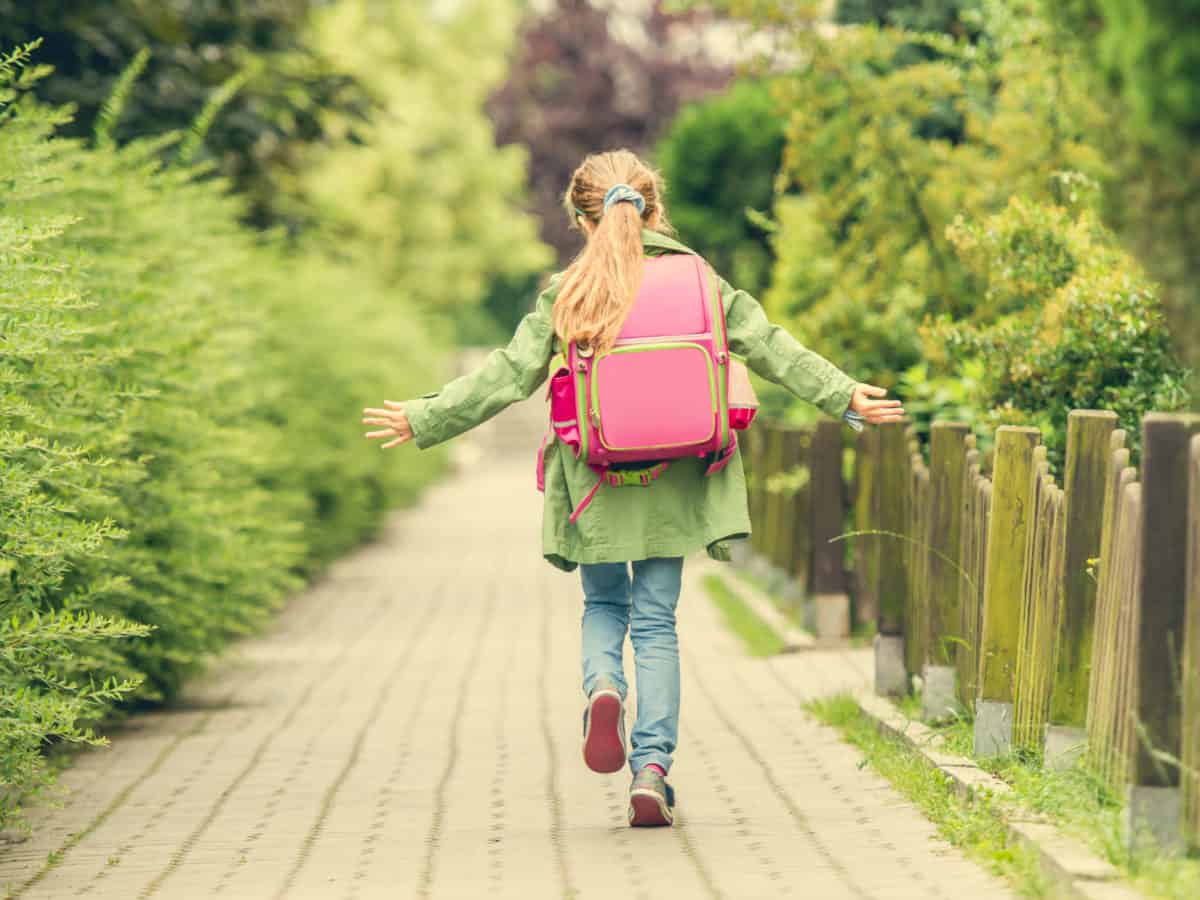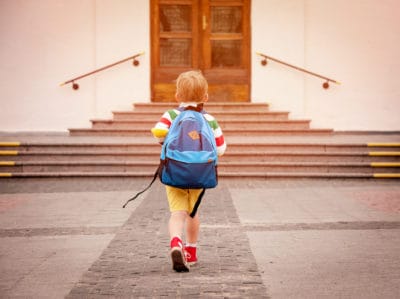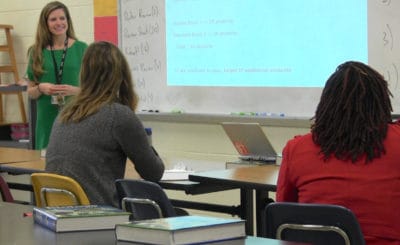
“I struggle the most with worry about my students. I worry about how they are doing, if they are getting their physical and emotional needs met. I wonder if they are getting the love and attention they need. I wonder if they are scared and if there is anyone that is telling them that it will be OK.
I hope they are getting regular access to food and I hope they are feeding their minds with some reading and math as well. I hope they are taking the time to play and explore while still being safe. I hope that they are all healthy and happy.” —Katherine Semenek, first grade teacher at Fairview Elementary in Rocky Mount.
When asked what she is struggling with the most right now, first grade teacher Katherine Semenek focused not only on her students’ academic needs, but their basic needs to feel emotionally and physically safe and supported during this difficult time. We know she is not alone in her concerns as teachers all across our state, and our country, are stuck at home wondering if their students are safe, being fed, and being cared for after an abrupt closing of schools that left most staff not even able to say goodbye or give a final hug to their students or colleagues.
Fairview Elementary and McGee’s Crossroads Elementary are two of 28 schools that the Public School Forum’s North Carolina Resilience & Learning Project has partnered with for intensive trauma-informed coaching and training this school year. Our team has been checking in regularly with project partner school staff since schools closed just over three weeks ago. We’ve been hearing from many school staff that in addition to remote learning challenges, the sudden closure of schools has caused considerable stress and trauma for many kids, parents, and educators.
“I just want to see my students face to face and hug them, shelter them from this madness that is going on outside, and just let them know everything will be OK.” —Danielle Meyers, EC Teacher at McGee’s Crossroads Elementary in Johnston County.
Undoubtedly, the social emotional learning and mental health needs of kids are greater now than ever before. We know many kids are facing a lack of basic needs at home or are in homes with safety risks related to abuse, neglect, or domestic violence. In addition to all of this, students are not able to be in the classroom to learn in the ways they are most used to, which increases fears that they will fall behind academically. This is particularly concerning for students with greater levels of need, including those with special needs and English language learners, who may not have access to the additional supports and resources they need while they are learning remotely.
So much focus right now is on understanding the needs of our kids while they are home — and we should be focused on them. At the same time, it is also important to consider the needs of our educators. Just as most kids left schools on Friday, March 13, thinking they would return to their classrooms the following Monday, so did our teachers. They assumed they’d be coming back to the kids they love and care about and returning to the classroom routines they are accustomed to.
Teachers are also being asked to attempt lesson planning and teaching in ways they have never had to do before with online learning and no planning time. We know educators are also a group used to a strong sense of togetherness and community with their colleagues, and they now are experiencing their own isolation away from supportive co-workers — and away from the students they care so much about.
“My biggest struggle is losing my favorite parts of teaching! I miss the smiles, the hugs, the connection. I miss their silly wit and the relationships we built. I miss our perfectly imperfect classroom community. Emails and Zooms will never replace that.” —Lauren Horne, fourth grade teacher at McGee’s Crossroads Elementary in Johnston County.
“All of our staff is really struggling with the upheaval to daily life that has happened in recent days. Like many people during this crisis, we feel stressed, anxious, and some report disrupted sleep. Our balance is off, and we don’t know when this will end.” —Carmen White, school counselor at McGee’s Crossroads Elementary in Johnston County.
Now that the initial shock of school closures has set in, many families and educators are asking, “What can we do now?” Watching the news feels heavy, getting up to face another day stuck at home feels heavy, figuring out how to educate and entertain our kids feels heavy, and even going to the grocery store feels heavy these days. Fortunately, while this is an unprecedented time for our world, humans are resilient, and there is much that we can each do every day to continue building resilience both for kids and adults.
With our North Carolina Resilience and Learning Project introductory training, we highlight four key areas of resilience for schools to focus on. While the ways in which these four areas are carried out may look different with kids not inside the school building each day, each area remains critically important for both student and educator resilience right now.
Staff self-care and wellness
We’ve all heard analogies like: if our cups aren’t full, we can’t fill up the cups of others. This is true now more than ever before. Even though educators are not in the classroom right now, they are still working vigorously to provide online lessons, connect with students and families, provide what support they can, and manage all of the changes and stress in their own personal lives. It is critical for educators to continue (or start!) taking time for their own self-care and reaching out to connect with their colleagues. Here are a few simple ideas to get you started.
- Take time to practice self-care each day with something you enjoy — reading a book, calling a friend, exercising and walking, cooking a good meal.
- Think about what your own “calm-down” strategies would be — how do you self-regulate when you feel upset or stressed? Deep breathing and mindfulness practices are two great ways to consider, and there are many apps offering free accounts right now for just this purpose — the Calm app, Headspace, Smiling Mind, and Stop, Breathe & Think.
- Stay connected with your friends and colleagues — call a friend or set up a virtual hangout. Create a buddy system with your colleagues so everyone has someone checking in on them every day or two, and think about how to create a virtual community with your school staff. Simple, fun ideas could include having staff post their favorite meme to social media, or for a virtual staff meeting, ask staff to wear their favorite t-shirt and share why it’s their favorite.
- Get outside when you can.
- Limit your news intake — while it is important to stay informed, too much can increase stress and anxiety.
- Focus on what you can control — habits like hand washing and social distancing, staying active, and finding ways to be a helper (from a distance!) for your friends, family, and community.
- Draw your attention to the good moments in your day — what we give our attention to grows!
- Consider a district-wide initiative such as “Wellness Wednesday” or “Feel Good Friday” that is one day of the week with limited academic content and instead is more focused on self-care and wellness for staff and students.
Maintaining relationships with students
Research shows more and more the importance of a caring adult in a child’s life, and in stressful times such as these, this is even more important. School staff have already been sharing creative ways that they’ve been working to communicate and maintain relationships with their kids.
- Creating short videos of themselves to send to kids or post on their social media pages or Google Classroom so kids can see and hear them.
- Making calls home to families.
- Hosting “virtual office hours” for kids to call in.
- Setting up virtual restorative community circles with their kids, similar to the circles they were doing in school.
- Starting any academic lessons or work with some kind of connection moment before diving into academic content — something as simple as asking everyone how they are doing and feeling that day
- Be creative! Some schools have had a virtual spirit week so each day kids are dressed up in different themed attire. We’ve seen staff do things like share with students pictures of themselves with their pets or sending a picture with a funny filter.
Supporting social-emotional learning at home
Many schools have started doing a lot of work around social emotional learning (SEL), recognizing that when kids are dysregulated, it is much harder for them to access the thinking part of their brain to learn. While in the middle of so much change, anxiety, and uncertainty right now, it is even more important to make sure we keep SEL at the forefront with our students (and families). Many educators and researchers are highlighting that SEL is even more important than academic learning during this crisis — we need to help kids feel safe and secure in the world around them. Here are some ideas that schools are using to continue SEL even while kids are at home.
- Sending home short SEL lessons or creating online SEL lessons, just like teachers are doing for academic content. If your school is using a curriculum like Second Step or Sanford Harmony, keep the lessons coming. If not, here are some places with great ideas for lessons you can share with your students: CASEL, Second Step, and Conscious Discipline.
- Hosting or creating content for kids to do morning meetings on their own at home — either with their families or virtually with the class.
- Doing virtual “temperature checks” with kids — using tools like a feelings thermometer or the Zones of Regulation to check in with students on how they are feeling each day.
- Share with parents and caregivers ideas for setting up a “calm-down space” in their house that is similar to what many schools have in classrooms — a designated space with different fidget toys, comforting items like stuffed animals, and self-regulation activities they know their child likes.
- Send home online mindfulness resources that have simple, already-created videos specifically for students to practice mindfulness skills: GoNoodle, Headspace, Smiling Mind, Stop, Breathe & Think.
Helping kids and families maintain a sense of structure and routine
All kids — and especially those experiencing stress and trauma — do much better with structure, routine, and clear expectations. They want to know what their day will look like and what is expected of them. This helps them feel emotionally and physically safe and secure.
Any “normal” routine for all students has been totally turned upside down right now, so anything educators can do to support families in creating some “new normals” and a sense of routine at home will help kids with their stress and anxiety in the midst of so much change. A few ideas:
- Sending home sample schedules for families to follow each day that are similar to the school day — starting with a morning meeting, having a lunch time, and definitely having extended recess outside, if possible. And don’t forget time for art and music!
- Help families think about how they could set up a designated small space for kids to use for school work that is separate from their play areas in the house.
- Keep any activities, lessons, or school assignments simple and straightforward with short and clear directions.
- Give yourself grace when set routines or schedules don’t go according to plan. We are all making this up as we go along, and you are doing great.
Whether you are a parent or caregiver, a teacher or administrator, or a student, we are all in this together. Though we each may be facing a different set of specific challenges, we all share uncertainty about the future — the future of the school year, the future of this pandemic, the future of businesses that have closed.
But greater still than this uncertainty is the certainty that human beings are resilient. Taking care of ourselves, finding new and creative ways to stay in touch with students, and continuing to support SEL and structure for kids are just a few things that are in our control and can be used to help support resilience right now — for yourself, for your students, and for their families.
While I feel unsure about a lot of things right now, one thing I am sure about is that we will come out on the other side of this as better leaders and educators for our students. Years from now, history will tell the story of how the world survived COVID-19 — and each of you will be a hero in that story.
Recommended reading



